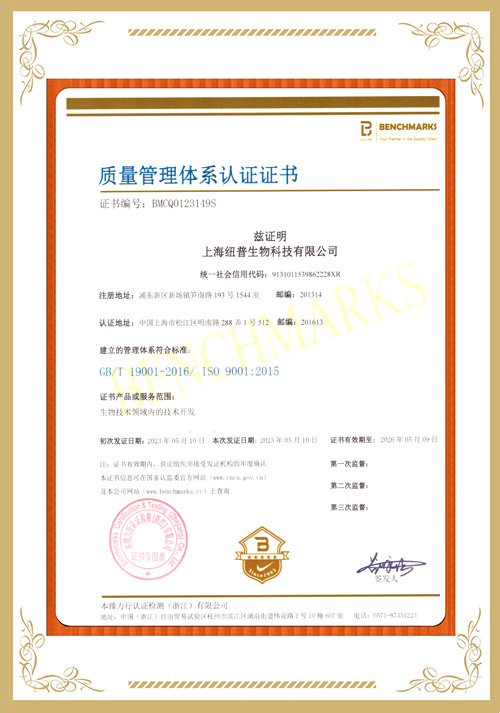- 抗体类型:多克隆
- 抗体来源:兔
- 抗体应用:WB, ELISA, IHC-P, IP
- 特异性:Influenza A H4N6 (A/mallard/Ohio/657/2002) Neuraminidase / NA
产品详情
-
产品名称
Anti-NA antibody
-
抗体类型
多克隆
-
抗体来源
兔
-
抗体亚型
兔IgG
-
抗体描述
Rabbit Polyclonal to H4N6 NA
-
抗体应用
WB, ELISA, IHC-P, IP
-
应用推荐
WB: 0.5-5 μg/ml
ELISA: 0.1-0.2 μg/ml
This antibody can be used at 0.1-0.2 μg/ml with the appropriate secondary reagents to detect Influenza A H4N6 (A/mallard/Ohio/657/2002) Neuraminidase / NA.
-
特异性
Influenza A H4N6 (A/mallard/Ohio/657/2002) Neuraminidase / NA
-
蛋白别名
NA, Neuraminidase, NA, NA, NA, Neuraminidase, NA, NA, Neuraminidase, NA, NA
-
制备方法
Produced in rabbits immunized with purified, recombinant Influenza A H4N6 (A/mallard/Ohio/657/2002) Neuraminidase / NA . Influenza A H4N6 (A/mallard/Ohio/657/2002) Neuraminidase / NA specific IgG was purified by Influenza A H4N6 (A/mallard/Ohio/657/2002) Neuraminidase / NA affinity chromatography.
-
组分
0.2 μm filtered solution in PBS
-
储存方法
This antibody can be stored at 2℃-8℃ for one month without detectable loss of activity. Antibody products are stable for twelve months from date of receipt when stored at -20℃ to -80℃. Preservative-Free.
Sodium azide is recommended to avoid contamination (final concentration 0.05%-0.1%). It is toxic to cells and should be disposed of properly. Avoid repeated freeze-thaw cycles. -
背景介绍
Neuraminidases are enzymes that cleave sialic acid groups from glycoproteins. Influenza neuraminidase is a type of neuraminidase found on the surface of influenza viruses that enables the virus to be released from the host cell.Influenza neuraminidase is composed of four identical subunits arranged in a square. It is normally attached to the virus surface through a long protein stalk. The active sites are in a deep depression on the upper surface. They bind to polysaccharide chains and clip off the sugars at the end. The surface of neuraminidase is decorated with several polysaccharide chains that are similar to the polysaccharide chains that decorate our own cell surface proteins.Neuraminidase (NA) and hemagglutinin (HA) are major membrane glycoproteins found on the surface of influenza virus. Hemagglutinin binds to the sialic acid-containing receptors on the surface of host cells during initial infection and at the end of an infectious cycle. Neuraminidase, on the other hand, cleaves the HA-sialic acid bondage from the newly formed virions and the host cell receptors during budding. Neuraminidase thus is described as a receptor-destroying enzyme which facilitates virus release and efficient spread of the progeny virus from cell to cell.Influenza antibody and influenza antibodies are very important research tools for influenza diagnosis, influenza vaccine development, and anti-influenza virus therapy development. Monoclonal or polyclonal antibody can be raised with protein based antigen or peptide based antigen. Antibody raised with protein based antigen could have better specificity and/or binding affinity than antibody raised with peptide based antigen, but cost associated with the recombinant protein antigen is usually higher. Anti influenza virus hemagglutinin (HA) monoclonal antibody or polyclonal antibody can be used for ELISA assay, western blotting detection, Immunohistochemistry (IHC), flow cytometry, neutralization assay, hemagglutinin inhibition assay, and early diagnosis of influenza viral infection.


